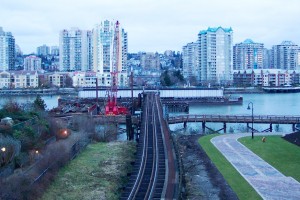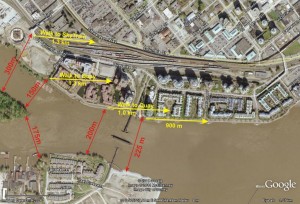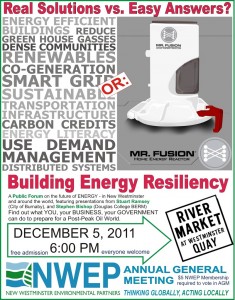Tag: Quay
The Trains of October -UPDATE
I guess once James Crosty stepped up to run for Mayor, it was inevitable that a distraction like train noise would become a central talking point in this election.
 |
| Vital transportation link or loaded shotgun? Actually, both. |
Based on recent comments in the local media, trains are either the worst thing that ever happened to New Westminster, or they are completely benign and only bother a couple of Nimby whiners. Like most things, the reality is somewhere in between the two. And like most political hot-button topics, there are numerous interacting issues here, none of them being addressed by the overtly-partisan letter-writers to the local papers. Yes, I’m talking to you, Ted Eddy.
First off, and pointed out by Matt Laird in a letter that garnered no feedback a few weeks ago, the issue that the Quayside Board and the esteemed Mr. Crosty was fighting is a completely different issue than train whistles and the City’s new plan to address whistle cessation. Matt should know: he is named in the court case, Mr. Crosty is not. The City doesn’t really have a horse in the first fight, but has significant input on the second. I’m not sure if conflating the two issues is particularly helpful, as any success we will make in whistle cessation is going to require participation with the railways in question and collaboration, not court fights.
Scott Larsen’s very long letter to both papers last week was a treatise on the “who gives a shit?” side of the argument. The thesis, that being “trains are here, love them or leave” is kind of unsatisfying.
I don’t see trains as different than any other business or resident in the City. They have a right to use their land and to do business, and to not be unnecessarily fettered by unreasonable neighbours. Like any other part of the community, they also have some (ethical, if not legal) responsibility towards their neighbours, and need to consider what reasonable accommodation they can afford their neighbours. Since Rail companies are not beholden to City Bylaws and do not pay property tax, there is little that Cities can do but respectfully request these accommodations, and work with the Rail Companies in a partnership to manage them. For this to happen, both sides need to be honest brokers, and the Rail Company needs to be concerned about the needs of their neighbours.
I have worked with railways on “emissions” issues in the past (emissions being the catch-all term for air pollutants, vibrations, and noise), and from my limited personal experience: the small guys are great to deal with, the two big Canadian railways are harder to deal with, and BNSF are a bunch of jerks. My suspicion is that this reflects their corporate structures, as the larger and more pan-national the organizations, the less accountability the guy across the table has to the community and the more he has to the “shareholders”, wherever they are.
In the case of the Quayside, it seems that efforts to be honest brokering fell apart years ago, although none of us really know what happened, as the agreement was kept confidential, and no-one is talking about it. However, continued engagement is the best bet the Quayside has, and Mr. Crosty and company should get kudos for doing so much to keep the issue moving along. I’m not sure conflict through the courts is the best approach, but I am on the outside, am not party to the confidential agreement, nor to their strategy discussions with their legal counsel. Here is the point: neither are most of the people commenting so vociferously about this issue! Therefore, you are criticising Mr. Crosty and the Quayside about something you don’t know anything about!
The most idiotic and useless part of this public discourse is the “they were here first” trope. Residential development pre-dates rails in New Westminster by at least 20 years. Of course, the rails were here before James Crosty moved to the Quayside, but James Crosty and many of the Quayside condos were there before SRY Railway (the current keeper of the bridge through the Quayside) was created, and down the rabbit hole we go. All of this built the idea that whoever is here first can do whatever they want, and anyone who comes later has to lump it. That is anti-community, anti-democracy, anti-development, anti-progress, and a silly argument for an adult to make.
That said, Mr. Crosty’s argument that the First Nations were really here first is kind of bizarre: I don’t think the First Nations experience is a good image to evoke about how newcomers should treat long-time residents…
His long response to Mr. Larsen’s letter the New Leader makes it clear that Mr. Crosty wants this issue to stay in front of the election. Which is too bad, because I think that there are other issues in the City that need more attention this election than the Quayside’s ongoing battle with the Railways. Clearly that is one issue that will not be solved in this election or during the next council term. The role of the City in finding that solution is also hard to define, and in the end, Mr. Crosty and Mayor Wright are on the same side of this fight: they want the rails and the people of the Quayside to peacefully coexist.
Finally, does anyone else think it is a bizarre that there was a lot of news, much generated by Mr. Crosty himself when the Court of Appeal hearing was held, now that the decision has been returned, and the Quayside appears to have lost, there has been no mention of this setback in the local news or on Mr. Crosty’s website?
UPDATE: Mr. Crosty sent me a message, and addressed some of the issues above. here is his note:
What you state is a loss may not be. We are waiting for the CTA to determine the outcome. The Judgement’s first page states the following:
“The appeal is allowed, the decision of the Agency is set aside and the matter is returned for re-determination in accordance with the reasons of the Court with one set of costs payable by the Canadian Transportation Agency to the Appellants.”
In other words the second complaint was rejected and the original complaint has yet to be dealt with. The CTA ruled on the second complaint this was rejected by the court hence the CTA is required to pay costs on this successful appeal by the rail companies.
As per usual court decisions are complicated matters we will not know what happens until the CTA convenes with it’s legal council. Sorry you have to wait but this is not a simple court case. We prefer to wait for the CTA to render it’s findings. The QCB has been patient, these things move slowly thru the system when it is the first time – after all we been waiting 5 years whats another week, month, or year 🙂 I trust you understand.
Like I said, I’m not a lawyer, and I am not in the middle of this case, so I am obviously missing a lot of the subtlety. Mr. Crosty’s trust is misplaced, as I really don’t understand. But the QCB has a strategy, so let’s wait to see where it goes before we pass any judgement.
Poplar Island, and a bridge to elsewhere.
It is the biggest stand of trees in New Westminster, and you have probably never been there.
Poplar Island has a rich history, which you can read about in some detail here. For those with stunted attention spans, it has been a rancherie, an Indian Reserve, a smallpox hospital (prison?), a shipbuilding centre, a home, and for most of the last 50 years, little more than a convenient place to boom logs. The history of ownership is about as chequered, and perhaps even a bit uncertain now…
I raise this issue now because some people have suggested that a bridge to Poplar may be a good idea, as part of the project to connect Queensborough’s perimeter trail system to the Boardwalk and Quayside, and finally provide a real community connection to Queensborough residents.
The problem is, attaching Poplar to this idea is a recipe for all kinds of troubles.
First off, that legacy of Poplar creates all sorts of legal issues around connecting to it. With a 100-year history of industrial activity, there is a clear history of Schedule 2 activities, so re-zoning it for Park would be somewhat complicated, even if there is not contamination present (actually, the logistics involved in doing the sampling required to determine if it is contaminated would be a real hassle for an island with no roads, no landing docks, and no services). Then if somehow the City got the rights to use the Island, and negotiated fair use with the appropriate First Nations, and got the contamination situation figured out, how do we go about controlling access to the park, preventing fires, stopping squatters, etc. I suspect there is a reason the island is being preserved in a relatively natural (if second- or third-growth) state…
I hate to be a Debbie downer. I think that a well-designed park, accessible and safe, with a proper emphasis on displaying the important heritage of Poplar, would be great benefit to the City, but it will take a long time and a fair pile of money to develop. Maybe in my second term as Mayor. So the risk here is a measured response to reclaiming Poplar Island will slow down the bridge project, potentially for decades.
Worse actually, is that Poplar Island does not represent a good place to put a bridge, if your goal is to connect the burgeoning communities of eastern Queensborough and their integrated greenways with the Boardwalk, the Quay, Skytrain, and the rest of downtown.
If we want to build a pleasant park trail to be used occasionally for dog walks, then let’s wait until we can get Poplar worked out and build the bridge then. If we want a piece of sustainable transportation infrastructure to connect Port Royal and the rest of Queensborough to the rest of the City, let’s at least put the bridge in a useful spot. That means ignoring Poplar for now.
 |
| (Click to make big enough to be readable. Hey Google Earth, your share of my profits are in the mail) |
As you can see in the above diagram, connecting just west of the train bridge to the trail just east of the little beach on Queensborough would require a bridge about 200m long (measuring between imaginary pillars set on opposite banks). The controversial “Submarine Park” location, more like 225m. Access via Poplar will require two bridges, totalling 325m at the closest points, of 475m to connect to the Third Ave overpass as was suggested by come commentors.
I recognize there is more to a bridge’s cost than a simple length calculation, but as a first approximation, isn’t it safe to suggest a shorter bridge is likely to be cheaper?
The second half of bridge location is that it connects to. As attractive as hooking into the Third Ave overpass may be aesthetically, I don’t think pedestrians from Queensborough are not all that interested in better access to Key West Ford (although I am sure their vehicle deals are second to none). They want to get to the Quay, to the Skytrain, and to Downtown New West and the new MUCF. So why take them so far away from their destination?
I think the Submarine Park is a minor issue, compared to building a bridge that acceptable to the local community from an aesthetics viewpoint, is accessible by more people, and serves its purpose as an important peice of sustainable transportation infrastructure.
The Submarine doesn’t have to move, and in the slim chance it has to, there are other locations it can go. At the Quayside Sale/Festival, I overheard Councillor Harper talking about the bridge with a concerned citizen, and addressing concerns that the “Submarine Park” was going to be removed. He said: “do you really think this Council is going to vote to remove a park?” The question may have been rhetorical, but it seemed to stump the questioner…
